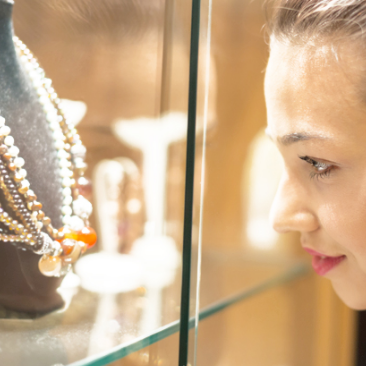
There’s an interesting opinion floating around the industry recently that asserts that traditional, glass-case fine jewelry stores are designed with male shoppers—not women—in mind.
The argument (the genesis of which I can’t find, but I’ll update this article if and when I do) is perhaps rational because fine jewelry store itself has always been buoyed in large part by the engagement ring buy, which, traditionally, involved future grooms meeting with sales people who educated them on the 4Cs of diamonds.
In that buying scenario, the knowledgeable salesman-behind-the-case deal works pretty well. Research has shown that male shoppers are generally comfortable with the one-on-one sales setup. Trust is established and eventually the sale gets made.
But does the equation—and the environment in which it plays out—work for self-purchasing women, who in 2014 made up 25 percent of the fine jewelry buying block, and undoubtedly comprise far more of that pie now?
The retail world has changed significantly in the past decade, and the ways consumers buy categories including makeup (hello, Sephora) and music (see Spotify and iTunes) have completely changed.
In the early days of the internet, it was almost unheard of that someone would buy a diamond online. Now it happens every day—likely every second.
I love jewelry stores. I love their icy glamour. And there’s nothing like feeling jewelry in your hand and seeing it sparkle under the lights. But like many self-purchasing female jewelry buyers I know, I ultimately buy most of my jewelry online, from multibrand retailers and directly from brands.
Why? Because on the internet, I can browse at midnight and buy at 5 a.m. It’s about convenience for me.
But for others, I believe that the idea of having to be helped with merchandise—as opposed to being able to browse alone, Sephora-style—is a huge turnoff. And that puts jewelers, who obviously need to maintain solid security around their high-ticket merch, in a real conundrum.
The third barrier for many is a lack of selection—compared, of course, to the internet (aka, the shop that has everything ). And that is something jewelry retailers can and should address.
I was reminded of this particular problem last week at a department store counter when I asked the sales person for a certain lip gloss: She spent 10 minutes trying to locate it before telling me it was out of stock.
After I thanked her and walked away from the counter, I bought the lipstick on my Amazon app with a single click. Walking. The entire experience underscored what many retail consultants have long tried to impart to their clients: There’s nothing you’re selling in your store that people can’t get online.
So how can brick-and-mortar retailers remain competitive and ensnare the self-purchasing woman?
In my opinion, staying on top of trends—and taking calculated risks in your buying—is a business-building endeavor.
Because you want every woman who walks through your front door to see something she’s never seen before—and absolutely has to have.
(Image courtesy of Jewelers Mutual)
Follow JCK on Instagram: @jckmagazineFollow JCK on Twitter: @jckmagazine
Follow JCK on Facebook: @jckmagazine